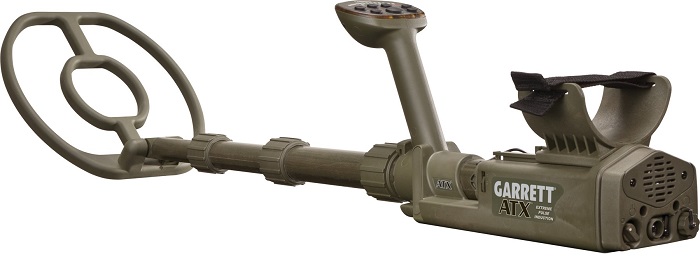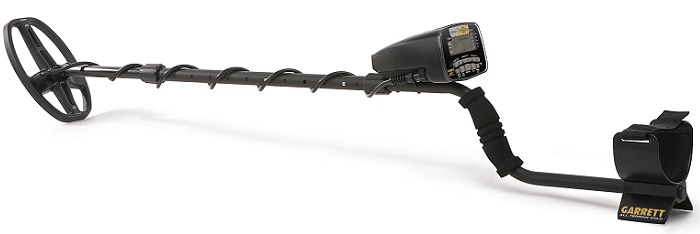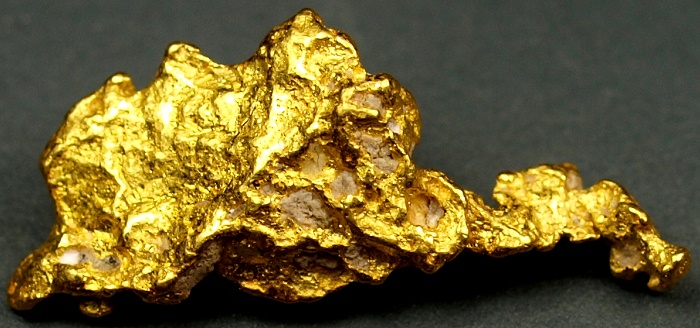Up until the last few years, there really weren’t any good options for nugget hunting underwater. The waterproof detectors on the market were designed for coin and relic hunting and weren’t all that good at finding gold nuggets.
The design of metal detectors has really improved in recent years, and now it seems that many of the newer gold detectors are either waterproof or water resistant.
For true underwater detecting, you need to make sure that the detector is truly waterproof, and is capable of being used at least a few feet of depth for a sustained period. This will allow you to explore most of the creeks and rivers out there. Even if you aren’t fully submerged, you can use these detectors safely knowing that an accidental slip into the water isn’t going to ruin their electronics.
If you are metal detecting for gold nuggets underwater, these are currently the three best gold detectors suited for the task.
Garrett ATX

The Garrett ATX is one of the metal detectors that can be used for all terrain conditions, and works beautifully in a desert wash just as well as it does underwater. For underwater use, the Garrett ATX can be submerged to 10 feet to search for potential target underwater, making it perfectly suited for nugget detecting in gold bearing rivers.
With the Garrett ATX, there are three ways to operate underwater, the first being the discrimination method. With the Garrett ATX, the level can be set to 3-7 and most of the responses will be eliminated in salt water conditions. Of course for gold hunting you will be in fresh water conditions most of the time so there will be less issues with faulty signals relating to salt conditions that you would find at the beach.
Discrimination is generally not recommended for nugget hunting in normal conditions, but since recovering metal targets underwater is considerably more difficult than it is on dry land, this may be the easiest option even if it means that some gold nuggets are missed.

Ground balance is not necessary in discrimination mode, however, this method may have the disadvantage of reducing detection for low conductivity items.
The second method is the Ground Balance Method. This method can greatly help in increasing the amount of detection for low conductive items, without any need of increasing the discrimination level. Ground balance is one of the most important skills required for metal detecting and therefore to obtain the optimum stability, the Ground balance must be balanced when there are any changes in the ground conditions. Using the detector in all-metal mode, this will be the most sensitive way to operate the Garrett ATX. However, ground balancing can be challenging if you are fully submerged underwater. If you are just wading it is probably the best way to go.
The third method is the Default Ground Balance Method. This method has its advantages and its disadvantages. The advantage is that, this method provides the highest amount of detection of low conductive targets. The disadvantage is that, this method can produce high amount of false responses due to changing ground conditions.
Just like on dry land, the coils should be swung smoothly and at a constant height. Allowing smooth transitions between ground conditions, will allow the detector to set itself at an optimum level for all the varying grounds.
Minelab SDC2300

The Minelab SDC 2300 is one of the most popular gold detectors on the market. It’s compact design, waterproof features, and sensitivity to small gold make it one of the best detectors on th market today.
Other than normal water conditions, it’s great for general wet conditions when other detectors have to be stowed away until the rain stops. The SDC 2300 can be submerged up to 10 feet and one of its key features is its ability to detect the smallest of gold, most of them weighing under 1 gram.
The SDC2300 uses Advanced MPF (Multi-Period Fast) Technology, which allows the detector to shift very quickly between the Transmit (Tx) and Receive (Rx) signals. Unlike conventional Pulse Induction, for which high sensitivity comes with extra ground noise, MPF technology allows for higher sensitivity with minimal residual signals. Therefore, with this technology in hand, SDC 2300 can detect very small and deeply buried gold even in highly mineralized soils.
Te SDC 2300 has two kinds of detecting modes, one known as the Normal Mode (orange 1-5) and the other is the Salt Mode (blue 1-3). The Normal Mode is the conventional mode for various kinds of ground conditions, whereas, the Salt Mode is mainly used in salt lakes and beaches, where there is a high content of saturated minerals.
Other than MPF technology, the SDC 2300 has the AGT (Automatic Ground Tracking), which measures the ground’s mineral contents and compensates for any change in the content. Along with AGT, the SDC 2300 has Fast Ground Balance, therefore allowing the detector to be optimally ground balanced and allowing it to transit smoothly.
The SDC 2300 has the ‘Enhance/Fine Gold’ kind of receive processing, which minimizes any false targets from highly mineralized soils, thereby allowing the detector to be more efficient. The smoothness of the threshold on the SDC 2300 is ideal for underwater hunting to eliminate the need to dig false targets.
The SDC 2300 is a great all-terrain detector and is built to handle tough conditions. Its compact, lightweight, can handle tough conditions and has incredible technology. For underwater gold hunting it is perhaps the best option available today.
Garrett AT Gold

The Garrett AT Gold is another all-terrain detector that can be submerged to up to 10 feet of water. It has a Digital Target ID, which allows for precise detection of the target. The number can go from 1 (highly ferrous metals) to 99 (metals like silver and gold). AT Gold also has the Adjustable Ground Balance Window Program, which allows the detector to have the proper ground balance, according to different ground compositions. With Adjustable Ground Blance Window, the detector ground balances properly and smooths out the ground signals, thereby allowing the user to hear the deeply buried targets.
Unlike the ATX and SDC
, the AT Gold is a very-low frequency (VLF) detector. This is a completely different technology which has advantages and disadvantages. The VLF detectors do not detect targets as deeply, and are a bit noisier to operate. However, the advantage of a VLF detector is its discrimination, which is quite accurate at determining ferrous and nonferrous targets. For underwater detecting this is very nice, because you can be more selective with your digging.
The AT Gold has the Iron Discrimination Adjustment, which allows the user to determine the amount of iron to be discriminated out. The adjustment can be set from 1 (no iron discrimination) to 44 (maximum discrimination). Furthermore, AT Gold has an iron audio feature, which can be used in any of its three detecting modes. This feature helps the user to identify undesirable targets like nails or bottle caps.
The AT Gold operates in the frequency of 18kHz, which enables the detector to detect small gold in fresh water along with rings, coins and other nonferrous targets. Furthermore, it has a fast recovery time, allowing the detector to be more efficient.
It is more suitable for fresh water than salt water because its ability to detect small gold comes with the cost of being reactive to saltwater’s conductivity. It will detect too many signals and its ground balance mode is not fit for saltwater. Of course, for the nugget hunter this isn’t really a problem.
When in deep water, make sure the detector is ground balanced for stability. Just like detecting above water, ground balancing the AT Gold is very important.
Adjust the sensitivity of the detector. The sensitivity should be adjusted according to the water’s mineral content. The user must also make sure the coil is swung at constant height to ensure a consistent threshold.
The Garrett AT Gold is a great choice for underwater gold detecting. It is also the least expensive option out there, plus its accurate discrimination makes it a great choice since rejecting iron targets will is very helpful when detecting in many rivers.

General Advice for Underwater Gold Detecting
When metal detecting for gold underwater, you may find that locating a single gold nugget will lead you to an area that has considerably more fine gold that a detector cannot hear.
Most commonly, this will happen when a nugget is located in a bedrock crack that is packed with material. You may only be able to hear one target and a nugget is recovered from the crack. DON’T just move on without thoroughly cleaning out that crack! If there was one nice nugget in there, it is highly likely that there are others that are down deeper in the crack that can’t be heard. There is also probably quite a bit of pickers and fines. Clean the crack of all its material and pan it out.
When detecting underwater, don’t just about using it to find gold nuggets, but also as a tool to help locate high-grade gold deposits that have not been discovered yet.
Also Read: Gold Detecting with the SDC 2300
And: 15 Metal Detectors that will Find Gold Nuggets







